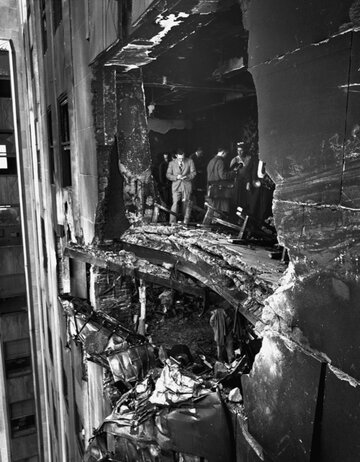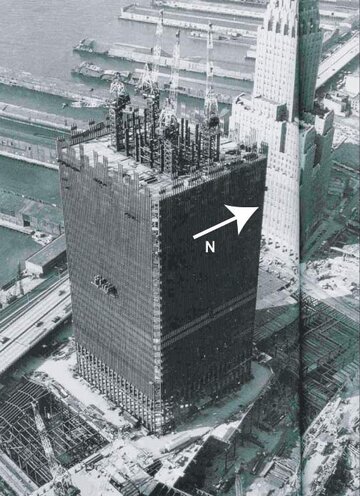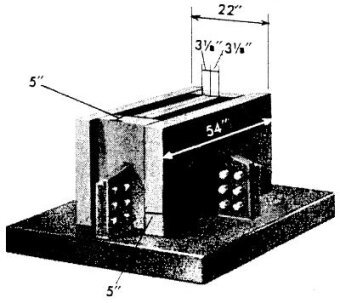I've posted this before, but it's a great explanation of why the towers fell the way they did and shows that not only did the collapse of the towers not violate the laws of physics but that they in fact followed them exactly as we would expect them to.
Static v. Dynamic Loading:
Why the WTC Towers Fell So Fast
Some conspiracy theorists are puzzled about why the WTC towers fell at almost free-fall speed on Sept. 11, 2001. They suppose that the speed of collapse is evidence that
something or
someone must have destroyed the structural integrity of the undamaged lower part of each tower.
After all, they reason,
"only the upper floors of the building were damaged, so why did the lower floors collapse, and why did they fall so fast?"
This web page answers those questions, simply enough for even a conspiracy theorist to comprehend (I hope). I do use some simple math and some very basic physics, but even if you don't understand that part you should still be able to comprehend the basic reasons that the towers fell so fast.
What the conspiracy theorists apparently don't understand is the difference between static and dynamic loading. ("
Static" means "while at rest," "
dynamic" means "while moving.")
If you don't think it can make a difference, consider the effect of a stationary bullet resting on your chest, compared to the effect of a moving bullet striking your chest. The stationary bullet exerts a static load on your chest. A moving bullet exerts a dynamic load.
As a more pertinent example, consider a 110 story building with a roof 1,368 feet high (like the WTC Twin Towers). Each floor is 1368/110 = 12.44 feet high, or aproximately 3.8 meters.
Now, suppose that the structural steel on the 80th floor collapses. (
Note: I'm using as an example 2 WTC, which was the building that collapsed first.)
The collapse of the 80th floor drops all the floors above (which, together, are equivalent to a 30 story building!) onto the 79th floor, from a height of aproximately 12 feet.
Of course, the structure of the lower 79 floors has been holding up the weight of the top 31 floors for many years. (That's the
static load.) So should you expect it to be able to hold that same weight, dropped on it from a height of 12 feet (the
dynamic load)?
The answer is,
absolutely not!
Here's why.
First, let's calculate aproximately how fast the upper 30 floors slammed into the 79th floor. (If you slept through high school physics, you may want to skip ahead to the result.)
d=distance,
g=acceleration of gravity,
t=time,
v=velocity
d = 0.5
g x
t²
Solving for
t:
2
d =
g x
t²
t² = 2
d /
g
t = sqrt(2
d/
g)
t = sqrt(2
d) / sqrt(
g)
v =
g x
t
Substituting for
t:
v =
g x sqrt(2
d) / sqrt(
g)
v =
g x sqrt(2
d) / sqrt(
g)
v = (
g / sqrt(
g)) x sqrt(2) x sqrt(
d)
v = sqrt(2
g) x sqrt(
d)
g = 9.8 m/sec²
d = 3.8 meters
Thus
:
v = sqrt(19.6 x 3.8) m/sec
v = sqrt( 74.5 ) m/sec
v = 8.6 m/sec
1 meter = 39.37 inches, so
v = 8.6 m/sec x (39.37/12) ft/m = 28 ft/sec.
which is
19 mph.
In other words, if you drop something from a height of 12 feet, it will be moving at about 19 miles per hour by the time it reaches the ground. It doesn't matter whether it is a single brick or a 30 story building. After falling 12 feet it will be moving at about 19 mph.
That's about the speed of a collegiate sprinter. (The world record for running the mile is 3:43.13, which is an average speed of 16.134 mph.) If you could sprint that fast and ran into a brick wall the impact might well kill you.
So if the lower 79 floors are strong enough to support a stationary 31 story building, do you think they will be strong enough to support a 31 story bulding falling at 19 mph?
The answer is emphatically no! But if you are not convinced, then ask yourself this roughly equivalent question. Suppose that you can hold up a 50 lb weight with little difficulty. Do you suppose that you could survive a 50 lb weight falling on you from a height of 12 feet - i.e., at 19 mph?
(Warning: Do not try this!)
To answer that question without killing someone, I devised the following experiment. First, I found an easily dividable weight
: I used my penny jar. Then I made a support for it
: I used a piece of notebook paper stretched over a loaf pan, and taped in place. As you can see, the paper was strong enough to support the jar
:
 (click on the photo for a close-up)
(click on the photo for a close-up)
(I was going to determine the limit to the amount of weight it would support, by adding pennies to the jar until the paper tore, but that's all the pennies I had in my penny jar.)
Then I removed the jar from the paper, and set it aside. I took five pennies from the jar, and taped them together. I stood on a stepstool, reached as high into the air as I could (about 9 or 10 feet from the floor), and dropped the 5 pennies onto the paper from that height. As you can see, even though I didn't drop it from a full 12 feet, the paper still could not withstand the falling pennies
:

(I took the pennies out of the loaf pan for this photo; that's them next to the lower-right corner of the pan.)
Then I weighed both the five taped-together pennies (12 grams), and the penny jar full of pennies (1372 grams)
:


As you can see, 5 taped-together pennies weigh just 1/114th as much as the penny jar, yet they tore the paper on the first try. (I didn't try an even smaller stack of pennies.)
You can imagine what would happen if I'd dropped the full penny jar on the paper from 10 feet up. If a 12 gram penny stack broke right though the paper, obviously the paper would hardly have slowed the 1372 gram jar full of pennies at all...
just as the lower floors of the WTC towers hardly slowed the fall of the upper floors.
That is experimental proof that a stiff (inelastic) structure which can support a given static load may break when less than 1% of that mass is dropped on it from a height of 10 feet. From that fact, it follows that if the full mass which the structure is capable of supporting is dropped on it from a height of 12 feet, the strength of the structure can be expected to slow the fall by less than 1%.
In the case of the WTC towers, there was a second factor which also slowed the collapse, but not by much. When the top 30 floors of a 110 story building fall 12 feet onto the 79th floor, due to the collapse of the 80th floor, the mass of the 79th floor is suddenly added to the mass of the falling structure. The momentum of a 30 story building falling at 19 mph suddenly becomes the momentum of a 31 story building falling at a slightly smaller velocity. The question is, how much smaller?
p = momentum =
m x
v
m1 = mass of the top 30 stories
m2 = mass of the top 31 stories = aprox. (31/30) x
m1
v1 = velocity before the additional mass is added = 19 mph
v2 = velocity after the mass is added
Momentum is conserved, so
:
p =
m1 x
v1 =
m2 x
v2 = (31/30) x
m1 x
v2
Solving for
v2:
v2 =
v1 x (30/31) = 0.968 x 19 mph = 18.4 mph
So you can see that the two factors which slowed the fall of the WTC towers were both very small. The strength of the structure below the point of collapse could be expected to slow the rate of collapse by less than 1%, and the accumulation of additional mass by the falling part of the structure due to the the "pancaking" of the lower floors could be expected to slow the rate of collapse by about 3%.
Of course, the above analysis is just about what happened when the top 31 stories fell onto the 79th floor. To predict the progression of the entire collapse, you have to repeat the calculations for each floor. For the next floor, calculate a 32-story building starting with an initial velocity of about 18.4 mph, and accelerating for another 12.4 feet to about 27 mph, and then slamming into the 78th floor. Since kinetic energy is proportional to velocity squared, the falling mass hits the 78th floor with about twice the kinetic energy that the top 31 stories had when they hit the 79th floor. Obviously, the 78th floor could be expected to slow the collapse by even less than the 79th floor did,
which is why the building collapsed at nearly free-fall speed.
Dave Burton
Cary, NC USA
Feb. 21, 2007
P.S. - Here's a video, created by Dave Thomas of NMSR.org, which illustrates that even a very short drop dramatically multiplies the force exerted by a falling object, as compared to a stationary object:
Mr. Thomas has also written
an excellent article about the physics of the Towers' collapse.
References:
- wtc.nist.gov: National Institute of Standards and Technology reports & information
- jod911.com - Journal of Debunking 911 Conspiracy Theories









 View full-size chart.
View full-size chart.


